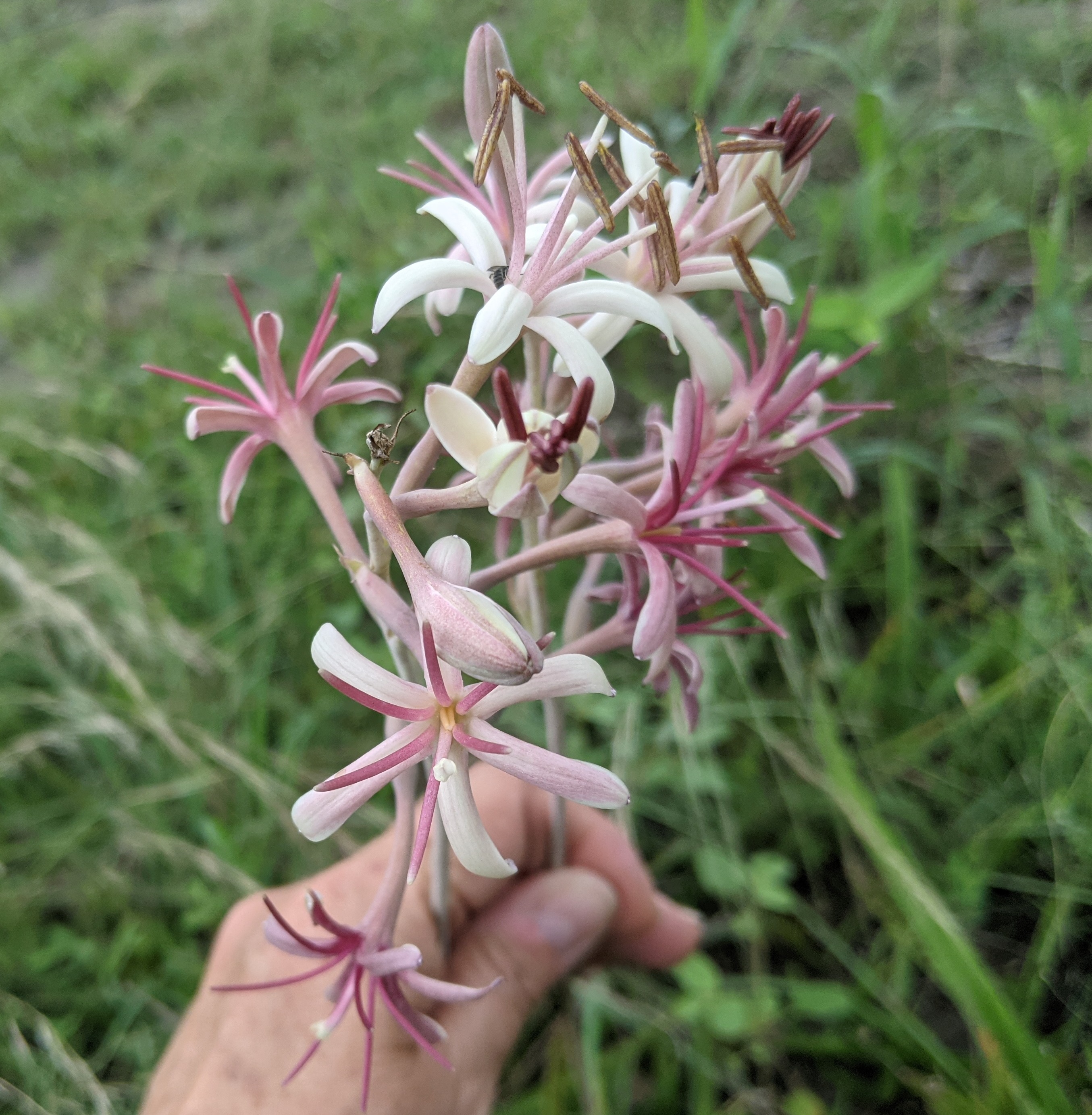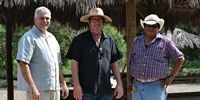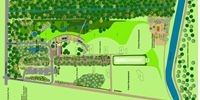Searching South Texas for Succulent Tuberoses
 As Published in American Butterflies, Summer/Fall 2022
As Published in American Butterflies, Summer/Fall 2022
Last September, Stephanie Lopez, who runs the native plant nursery at the National Butterfly Center, and I went on a little field trip. Well, I suppose I should say it was “little” by Texas standards, in that we only drove about 3 hours to get to our destination. If you’ve never made the trek to the tip o’ Texas, you may be unfamiliar with just how far south of South Texas the Rio Grande Valley really is; but, this nearly 200 mile excursion didn’t even take us to San Antonio, the geographical “gateway” to the rugged and romanticized, rattlesnake paradise that spills into the subtropics and reaches the border to Mexico, with whom we share culture, food, traditions, language and a colonial history longer than that of most of the United States. Here, near the edge of the ancient Giant Oyster (Crassostrea gigantissima) beds that lay where the Tejas Gulf Coast was once below sea level, the sandy soil, dense clay and salinity sustain habitat that is just right for another giant, the Manfreda Giant-Skipper. The succulent host for this almost-mythical butterfly is also called manfreda, cousin to the better-known agave.
While the Aztecs prized agaves as a gift from the gods, Jeffrey Glassberg treasures manfreda. Specifically, he elevates and desires two species, Spice Lily (spotted tuberose), Manfreda maculosa and Longflower Tuberose, Manfreda longiflora, the two known hosts for Manfreda Giant-Skipper, a globally, critically imperiled (G1) ranked butterfly.
Glassberg’s determination to save this species is a prime motivating factor in the North American Butterfly Association’s acquisition of Pixie Preserve, formerly, The Nature Conservancy’s Chihuahua Woods Preserve. This 350-acre property is close to the Rio Grande River to the south, and bordered by Ojo de Aqua (Eye of Water or Wellspring) Road to the west, as the delta winds toward the Laguna Madre. Although the river is naturally saline—about 1,000 parts per million at El Paso—the aquifer is even saltier, as evidenced by the sparkling crystals that shimmer on the topsoil at Pixie, where water bubbles to the surface and evaporates, especially in drought. In fact, both of these water sources are so salty (and becoming more so,) they cannot, technically, be classified as fresh water; but this seems to be what manfredas like best.
Historically, a copious population of manfreda could be found on the loma, or hill, at Pixie, where nitrate-rich silt is found atop caliche, a hardened natural cement of sand and gravel peculiar to semiarid regions. This sits above a layer of clay. Despite many attempts to locate manfreda, here, over the last several years, we’ve come up empty-handed; however, everything obvious about this environment says it is perfect for this persnickety plant, so, we continue to search…
And that is how Stephanie and I wound up traipsing along a rural highway, parallel to the Conquistador’s old Camino Real, with a merry band of Texas Master Naturalists, the U.S. Fish & Wildlife state botanist, a university professor and the county commissioner.
Now, let me back up. Glassberg has hounded me about manfreda, (both the butterfly and the plant,) for a decade, but they’re exceptionally hard to find and funding for work related to them has been nonexistent. Enter the James A. “Buddy” Davidson Charitable Foundation, associated with Texas Tech University in West Texas. For many years, the foundation has generously stepped in to supply the National Butterfly Center with funding for essential equipment, as well as agronomy-adjacent educational programs. For this reason, when they emailed in August of 2020, to say they had a little extra cash to distribute, I pitched the Manfreda Conservation Project, much to Glassberg’s delight. Even more delightful was the foundation’s decision to seed this foray, consisting of scouting, surveys, field observations, seed collection, propagation and the creation of test beds, all in the hope of augmenting or reintroducing both the plant and the butterfly to Pixie Preserve.
We began by expanding our research “on paper” into legacy and current, known populations of Manfreda maculosa and Manfreda longiflora. This meant reaching out to USFWS and Texas Parks and Wildlife Department’s botanists; tapping local experts, notably, Ken King the co-author of Plants of Deep South Texas; perusing iNaturalist; publicizing our quest; and engaging knowledgeable plant and butterfly people from Central Texas to the border, including NABA members, the Austin Butterfly Forum and TPWD’s former, invertebrate entomologist, Mike Quinn. Thanks to input from all of these excellent resources, we wound up expanding our geographical search area from 11 to 17 counties, and from 12 to an astounding 53 sites!
Of course, none of that would have been possible without the generous contributions of two, especially knowledgeable people and more than a dozen, dedicated volunteers. First, Chris Best, the state botanist for USFWS, created a priceless, guiding document, Manfreda Survey Instructions, for use by volunteers; and Camille Rich, a former teacher and current owner of El Mesteño Ranch, put together a brilliant, photographic tutorial on how to safely search for manfreda in the wild, based upon years of experience locating and observing it in the Tamaulipan thornscrub on her property.
Finding manfreda can be a most treacherous and challenging game of hide-and-seek, unless you’re well informed and prepared for the terrain, which is home to black widows, coral and rattlesnakes, Africanized bees and a wide variety of hostile, companion plants. The manfreda’s “growing buddies,” as Rich refers to them, are some of the most hazardous plants on the brushlands, and they have common names like prickly pear, Horse Crippler, Spanish dagger, pencil cactus and catclaw. If you’ve ever attended the annual Texas Butterfly Festival at the National Butterfly Center, you’ve probably heard me say, “Everything in South Texas fights for its life,” and manfreda is unique only in that it does not sting or tear one’s flesh; rather, it grows in the shadow of, and surrounds itself with, almost all of the ones that do! When searching for manfreda, any sign of this rogue’s gallery of stabbing succulents is a good one.
The viable range for manfreda is further narrowed by the typical presence of additional buddies, including Texas wild olive, and an evergreen group of drought-hearty trees and shrubs, namely Blackbrush Acacia, Colima (Lime Pricklyash), Guajillo and the highly-toxic host to the Two-barred Flasher, Coyotillo, which only grows in 32 Texas counties. Some of these counties get plenty of precipitation, so the manfreda grow well and are relatively easy to see in close proximity to their buddies. Although, in drought-affected areas, the manfreda dry up and retreat beneath the surface of the earth or go dormant, so they may be impossible to detect. In many cases, there may be just a portion of one or two little shoots peaking out, like creeping starfish arms, tentatively reaching to catch a bit of moisture and sunshine.
To help us cover as much ground as possible, we distributed a press release and call for volunteers to participate in the Manfreda Conservation Project to media outlets in 21 counties, as well as online and in our e-newsletter. Twenty-two people responded and nearly all of them logged on for our virtual trainings in March of 2021. Of course, the COVID-19 pandemic was still in bloom, with many not yet vaccinated; but our respondents were mainly couples or housemates, who felt comfortable venturing out together to survey the landscape, after being shut in for nearly a year.
Fortunately, many of them were also Texas Master Naturalists or knowledgeable outdoorsmen and women, so they were familiar with the places assigned to them, sometimes by site name, but also by GPS coordinates. As a result, everyone was ready to roll by April 1, 2021, for a survey and observation period we expected to last 6 – 8 weeks based upon manfreda’s normal, seasonal flowering cycle. However, we were thrown for a loop by Winter Storm Uri, which sent the entire state into a deep freeze that shocked or killed a lot of the plant life in manfreda’s very limited range.
Instead of running from April to June-ish, the project wound up running through early September. As our all-volunteer troops scoured cemeteries and state parks, public rights-of-way and private ranchlands, there were many disappointments, such as an absence of manfreda, like we’re seeing at the Pixie Preserve. Some of this may be from predation, as javelina voraciously consume manfreda as a thornless delicacy in a sea of needle-covered nourishment. Still, other sites were scraped, plowed under and paved as roadways were widened, or mowed for easement maintenance by government work crews.
There were some bright spots, though. One volunteer sent us a photo of a manfreda in flower with a towering stalk nearly as tall as a full-sized man. He was exuberant in emailing, “This is the tallest manfreda bloom stalk I’ve ever seen!” And the single greatest discovery was a patch of 959 “new” plants in Central Texas, which brings me back to where we started, with Stephanie and our happy, roadside search party.
True to Texas, as we walked too close to the fence line along private property a rifle rang out, firing a warning shot toward us wayward wanderers, lest we think about trespassing (which can be a capital crime in a castle doctrine state). In the distance, we could see a man standing beside his red Ranger ATV, with the rifle on his shoulder.
“Hey, Bill! It’s Tom!” yelled the elected official, arms outstretched overhead in an exaggerated wave, “Don’t shoot!”
The landowner approached the fence and his neighbors explained we were the folks they told him about, “the butterfly people” who came to see the rare plants growing between his fence and the road. From where Bill was standing, the plants didn’t seem rare, but we were obviously gobsmacked and grinning, especially since stands of 1,000 or more manfreda are reportedly required to sustain a population of Manfreda Giant-Skipper. This enormous stand had a “mirror” stand across the street, a little further down the road, where the fence line was obscured and overtaken by Texas persimmon. Both stands and the persimmon had gone to seed, so Chris Best, Christopher Gabler from the University of Texas-Rio Grande Valley, the local naturalists and Stephanie were all able to collect manfreda seed for the next phase of the project. Gabler also dug up soil samples for analysis, to find out as much as possible about the roadside conditions where this population was clearly thriving.
Since then, Best, Gabler, the naturalists and Stephanie have all managed to propagate manfreda and transplant it. At the National Butterfly Center, it’s going into six test beds with different soil composition, slope for drainage and sun exposure to see what may work best for a captive population, in the hope that we may be able to re-establish immense manfreda stands at Pixie and elsewhere. Gabler has also taken soil samples from Pixie to send to the lab for chemical analysis, including salinity, as this seems to be intensifying in the Rio Grande Valley, as the result of more concentrated, commercial agricultural practices, increasing population density and climate change.
Of course, the biggest disappointment of the survey period was the lack of evidence of Manfreda Giant-Skipper activity. No one observed chimneys used by larvae to climb the stalks or webbed tents on the leaves, and no one was lucky enough to encounter the butterfly that was presumed extirpated from the United States, until several years ago, when individuals were observed on private property by a scientist from North Texas.
In late August or early September, we hope to make the trek north, again, to check on this massive stash of host plants that might sustain the Manfreda Giant-Skipper, a natural treasure few have seen. If they can be saved, we hope to accomplish this in partnership with our members and partners, whose contributions to conservation continue to amaze! As always, we are grateful for their participation and the support of the James A. “Buddy” Davidson Charitable Foundation in this initiative, which is the first step in determining the extent to which this very special Texan still has a home here.










 Media
Media